-
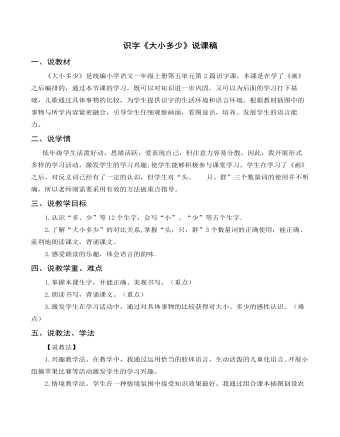
部编人教版一年级上册识字《大小多少》说课稿
五、说教法、学法【说教法】? ???1.兴趣教学法。在教学中,我通过运用恰当的肢体语言、生动活泼的儿童化语言,开展小组摘苹果比赛等活动激发学生的学习兴趣。? ???2.情境教学法。学生在一种情境氛围中接受知识效果最好。我通过组合课本插图创设农家小院情境,通过文本和课件互为直观感知,调动学生的多种感官直接参与学习.? ???3.赏识教学法。低年级的孩子喜欢被表扬。在学生练字,读词、展示学习成果等环节,我灵活运用针对性较强的赏识语言、友善的动作等方式对学生加以赏识。? 【说学法】?1.让学生在合作探究中学。合作探究学习关注的是学生的能力,我通过让学生互相探究记字方法,联系生活自编儿歌,让学生的思维力,想象力,创造力得到充分的展示。???2.让学生在读中学。朗读是学生获得情感体验的重要途径。本课教学以读为本,有目的组织形式多样的读词,读文活动,在反复的诵读中,体会韵文的语言美。???3.让学生在快乐中学。我们常说寓教于乐。本课教学我开展形式多样的教学活动,如开火车游戏,拍手读,小组比赛等,让学生在快乐中积累了语言文字。
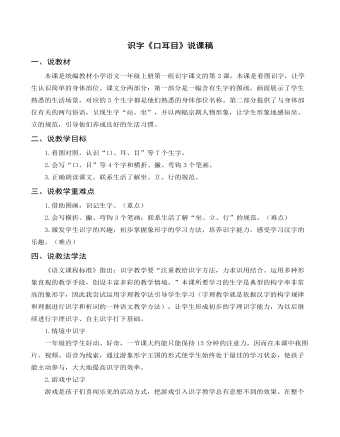
部编人教版一年级上册识字《口耳目》说课稿
一、说教材本课是统编教材小学语文一年级上册第一组识字课文的第3课,本课是看图识字,让学生认识简单的身体部位。课文分两部分:第一部分是一幅含有生字的图画,画面展示了学生熟悉的生活场景,对应的5个生字都是他们熟悉的身体部位名称。第二部分提供了与身体部位有关的两句俗语,呈现生字“站、坐”,并以两幅京剧人物形象,让学生形象地感知坐、立的规范,引导他们养成良好的生活习惯。 二、说教学目标1.看图对照,认识“口、耳、目”等7个生字。2.会写“口、目”等4个字和横折、撇、弯钩3个笔画。3.正确朗读课文。联系生活了解坐、立、行的规范。三、说教学重难点1.借助图画,识记生字。(重点)2.会写横折、撇、弯钩3个笔画;联系生活了解“坐、立、行”的规范。(难点)3.激发学生识字的兴趣,初步掌握象形字的学习方法,培养识字能力,感受学习汉字的乐趣。(难点)
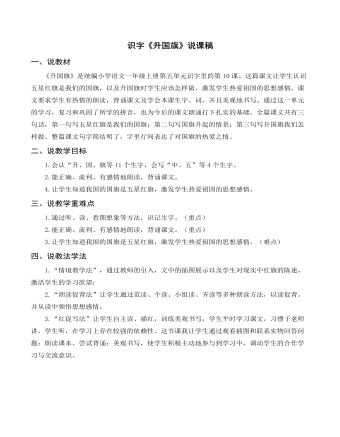
部编人教版一年级上册识字《升国旗》说课稿
一、说教材《升国旗》是统编小学语文一年级上册第五单元识字里的第10课。这篇课文让学生认识五星红旗是我们的国旗,以及升国旗时学生应该怎样做,激发学生热爱祖国的思想感情。课文要求学生有热情的朗读,背诵课文及学会本课生字、词,并且美观地书写。通过这一单元的学习,复习和巩固了所学的拼音,也为今后的课文朗诵打下扎实的基础。全篇课文共有三句话,第一句写五星红旗是我们的国旗;第二句写国旗升起的情景;第三句写升国旗我们怎样做。整篇课文句字简结明了,字里行间表达了对国旗的热爱之情。二、说教学目标1.会认“升、国、旗等11个生字,会写“中、五”等4个生字。2.能正确、流利、有感情地朗读,背诵课文。4.让学生知道我国的国旗是五星红旗,激发学生热爱祖国的思想感情。
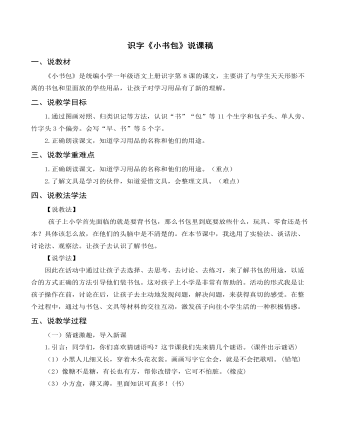
部编人教版一年级上册识字《小书包》说课稿
二、说教学目标1.通过图画对照、归类识记等方法,认识“书”“包”等11个生字和包子头、单人旁、竹字头3个偏旁。会写“早、书”等5个字。2.正确朗读课文,知道学习用品的名称和他们的用途。三、说教学重难点1.正确朗读课文,知道学习用品的名称和他们的用途。(重点)2.了解文具是学习的伙伴,知道爱惜文具,会整理文具。(难点)四、说教法学法【说教法】孩子上小学首先面临的就是要背书包,那么书包里到底要放些什么,玩具、零食还是书本?具体该怎么放,在他们的头脑中是不清楚的。在本节课中,我选用了实验法、谈话法、讨论法、观察法。让孩子去认识了解书包。【说学法】 因此在活动中通过让孩子去选择、去思考、去讨论、去练习,来了解书包的用途,以适合的方式正确的方法引导他们装书包。这对孩子上小学是非常有帮助的。活动的形式我是让孩子操作在前,讨论在后,让孩子去主动地发现问题,解决问题,来获得真切的感受。在整个过程中,通过与书包、文具等材料的交往互动,激发孩子向往小学生活的一种积极情感。
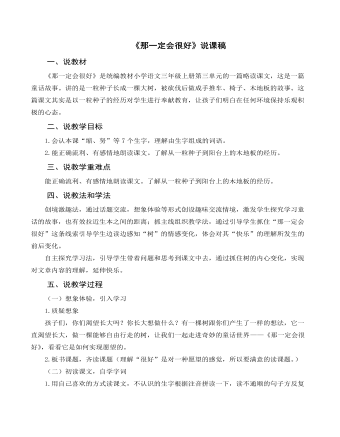
部编人教版三年级上册《那一定会很好》说课稿
一、说教材《那一定会很好》是统编教材小学语文三年级上册第三单元的一篇略读课文,这是一篇童话故事。讲的是一粒种子长成一棵大树,被砍伐后做成手推车、椅子、木地板的故事。这篇课文其实是以一粒种子的经历对学生进行奉献教育,让孩子们明白在任何环境保持乐观积极的心态。 二、说教学目标1.会认本课“缩、努”等7个生字,理解由生字组成的词语。 2.能正确流利、有感情地朗读课文。了解从一粒种子到阳台上的木地板的经历。 三、说教学重难点能正确流利、有感情地朗读课文。了解从一粒种子到阳台上的木地板的经历。
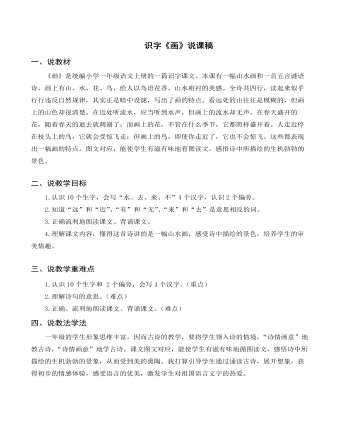
部编人教版一年级上册识字《画》说课稿
二、说教学目标1.认识10个生字,会写“水、去、来、不”4个汉字,认识2个偏旁。2.知道“远”和“近”、“有”和“无”、“来”和“去”是意思相反的词。3.正确流利地朗读课文、背诵课文。4.理解课文内容,懂得这首诗讲的是一幅山水画,感受诗中描绘的景色,培养学生的审美情趣。三、说教学重难点1.认识10个生字和 2个偏旁,会写4个汉字。(重点)2.理解诗句的意思。(难点)3.正确、流利地朗读课文、背诵课文。(难点)四、说教法学法一年级的学生形象思维丰富,因而古诗的教学,要将学生领入诗的情境,“诗情画意”地教古诗,“诗情画意”地学古诗。课文图文对应,能使学生有滋有味地循图读文,感悟诗中所描绘的生机勃勃的景象,从而受到美的熏陶。我打算引导学生通过诵读古诗,展开想象,获得初步的情感体验,感受语言的优美,激发学生对祖国语言文字的热爱。
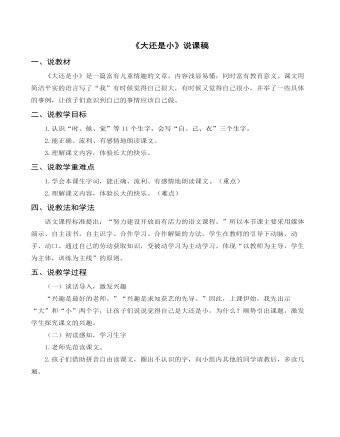
部编人教版一年级上册《大还是小》说课稿
二、说教学目标1.认识“时、候、觉”等11个生字,会写“自、己、衣”三个生字。2.能正确、流利、有感情地朗读课文。3.理解课文内容,体验长大的快乐。三、说教学重难点1.学会本课生字词,能正确、流利、有感情地朗读课文。(重点)?2.理解课文内容,体验长大的快乐。(难点)四、说教法和学法语文课程标准提出:“努力建设开放而有活力的语文课程。”所以本节课主要采用媒体演示、自主读书,自主识字、合作学习、合作解疑的方法。学生在教师的引导下动脑、动手、动口。通过自己的劳动获取知识,变被动学习为主动学习。体现“以教师为主导,学生为主体,训练为主线”的原则。
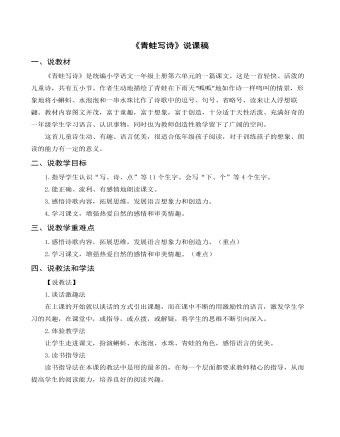
部编人教版一年级上册《青蛙写诗》说课稿
一、说教材《青蛙写诗》是统编小学语文一年级上册第六单元的一篇课文。这是一首轻快、活泼的儿童诗,共有五小节。作者生动地描绘了青蛙在下雨天“呱呱”地如作诗一样鸣叫的情景,形象地将小蝌蚪、水泡泡和一串水珠比作了诗歌中的逗号、句号、省略号,读来让人浮想联翩。教材内容图文并茂,富于童趣,富于想象,富于创造,十分适于天性活泼、充满好奇的一年级学生学习语言、认识事物,同时也为教师创造性教学留下了广阔的空间。 这首儿童诗生动、有趣、语言优美,很适合低年级孩子阅读,对于训练孩子的想象、朗读的能力有一定的意义。二、说教学目标1.指导学生认识“写、诗、点”等11个生字。会写“下、个”等4个生字。2.能正确、流利、有感情地朗读课文。3.感悟诗歌内容,拓展思维,发展语言想象力和创造力。4.学习课文,增强热爱自然的感情和审美情趣。三、说教学重难点1.感悟诗歌内容,拓展思维,发展语言想象力和创造力。(重点)?2.学习课文,增强热爱自然的感情和审美情趣。(难点)
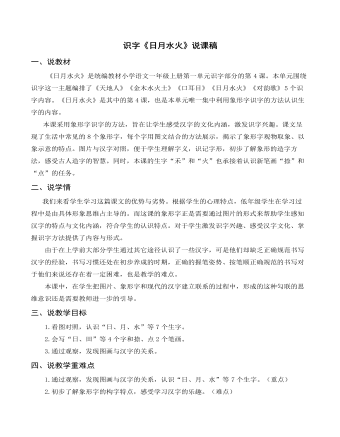
部编人教版一年级上册识字《日月水火》说课稿
1.兴趣教学法。低年级学生注意力持续时间短,容易分散,而兴趣是解决这个问题的关键。在教学中,我通过运用恰当的肢体语言和生动、活泼的儿童化语言;形式多样的识字游戏;从始至终让孩子们的注意力都放在课堂上,达到识字和组词的目的,提高识字能力。??? 2.情境教学法。这是从激发学生的学习兴趣和体现学科整合这两方面去考虑的。在教学中我通过图画,生动形象的板书,卡片游戏,小组比赛的形式重现知识情境调动学生的多种感官直接参与学习,在创设的情境中促使学生更好地识字。3.赏识教学法。没有赏识,就没有教育。在学生练读字,词、参与游戏、展示学习成果、教师相机指导等环节,我活用赏识语言;当众表扬赏识;用欣赏、赞许的目光赏识;用友善的动作赏识;用模糊赏识等赏识方式激发学生学习的兴奋点,给学生注入了巨大的学习动力。

人教版新目标初中英语七年级下册Where is the post office教案2篇
Period 2 (3a----Section B 2c)Preview(Pre-task): Key points: What laAdd another information about their pen pals----their language on the cardnguage does she/he speak?She/He speaks....Does she/he have any brothers and sisters? Does she/he speak English?Preview(Pre-task): Add another information about their pen pals----their language on the cardKey points: What language does she/he speak?She/He speaks....Does she/he have any brothers and sisters? Does she/he speak English?Step 1 Revision1.Revisionand dictation of the new words 2.Revise the drills they learned yesterday.(by pairwork and grammar exercise)Step 2 Leading-inT has a conversation with one student. The conversation is following:---Do you have a pen pal?---Yes, I do.---What's your pen pal's name? ---His/Her name is....---Where is your pen pal from? ---He/She is from...---Where does he/she live? ---He/She lives in....---What language does he/she speak?He/She speaks...Write the new words on the Bb. They are following: EnglishChineseJapaneseFrenchStep 3 LearnLearn the new words with the whole class.Finish 3a with the students3b Pairwork T still does an example with one student Then the Ss practise in pairs. The example is following:--Curry Muray is my pen pal. He is from the United States.---What language does he speak?

人教版新目标初中英语七年级下册I ’d like some noodles教案
教学过程Step 1: warming-up Sing a song---------“food and drink” Step 2: Revision1 Dictation2 Revise: What kind of noodles would you like?I’d like …What size bowl of noodles would you like?I’d like…Step 3: Presentation1 show pictures of food, ask students say the words.2 Students read the newspaper ad in 3a. Fill in blanks with words in the box. Then read the ad together, the teacher explains some difficult language points.3 Check the answers Step 4 PracticeAsk students to finish 3b in the same way according to 3a. Students read the short passage and fill in the blanks .At last, check the answers.Step 5 productionAsk students to write their own ad for dumplings, noodles, drinks, and other foods they know. Then ask students to read their partner’s ad. Then order food and drink from their partner.Step 6 Home workGroup work – make an ad about “food and drink”

人教版新目标初中英语七年级下册Where is your pen pal from教案
2.1Match the country with the language.Step II Reading3a? let the students read the letter fast and answer the questions.? Let the students ask more questions about the letter as possible as the can.Step III Writing3b.Step IV. Pairwork2cStep V Listening2a, 2bStep V. HomeworkExercises book(1) P3Exercises book (2) P3Period FourStep I . Dictate the words and sentences in Unit1.Step II. Self-checkStep III. Check the answers for Exercises book in the unit.Step IV. Home workRevise and preparation for unit 2.教学反思:通过本单元的学习,学生基本可以谈论人们的国籍,居住城市及其所说的语言,通过书信方式去介绍自己并寻找笔友。但在涉及到国外的一些城市时,学生对这方面的知识相对欠缺,能介绍的城市并不多,也反应出学生课前预习不充分,这跟学生学习条件也有关,大多数学生无法通过网络获取所需信息。因此,在以后的教学中要多指导学生通过计算机网络获取信息,拓宽知识面。

人教版新目标初中英语七年级下册Why do you like koalas教案2篇
单元整体说明(一)单元教材分析本单元的核心话题是描述动物和表达个人喜好,以及句式why do you like…? Because…。这也是本单元的教学重点。通过本单元的学习,学生应能较流利地运用所学词汇和句型描述动物,表达个人喜好。(二)单元知识结构1.词汇动物名称 tiger, elephant, koala, dolphin, etc.词汇描述性形容词: smart, cute, ugly, clever, shy, etc.国家名: Australia, South Africa2.句型Why do you like koala hears? Because they are cute.Where are pandas from? They're from China.What animals do you like? I like dolphins.(三)单元整体目标1.Master the vocabulary2.Master and use: Why do you like koalas? Because they am cute.Where are pandas from? They're from China.What animals do you like? I like dolphins.(四)单元教学重难点一览(五)单元学情分析学生此前已经学过由why, where, what 引导的特殊疑问句句型,具有了学习本单元知识的认知前提。形形色色的动物能激发学生的好奇心,产生了解它们的欲望,这有利于本单元知识的教学和学生学习兴趣的培养。

人教版新目标初中英语八年级下册What should I do教案2篇
说明:在帮Li Lei提建议的同时,教育学生如何学好英语。第三课时教学目标1. 语言目标:a) 词汇: Original, in style, haircut, the same as.b) 语言结构:My friend wears the same clothes and has the same haircut as I do.2. 能力目标:大多数学生能够谈论自己喜欢哪种服装,提高查找信息的能力。3. 情感目标:学会如何与朋友相处,要有自己对时尚的看法。教学重点掌握一些重要词汇。教学难点学会谈论问题,并能提出书面建议。◆教学突破首先针对Erin的问题,提出个人的建议,模仿2c部分的对话展开双人交际Pair-work;听老师诵读3a部分的信件,并找出LEFT OUT的问题所在;学生完成3b部分的内容,给Left Out提出书面的建议;学以口头形式提出自己目前存在的某个问题,讲给大家听,让同学们给自己提出一个建议,并作笔录;学生两、三个人分成一组,随意性地进行口语交际,谈论P14的第4部分的某个问题,相互交换意见。

人教版新目标初中英语八年级下册It’s a nice day, isn’t it教案2篇
"Hello! Welcome to English class! Introduce yourself. Meet your new classmates." That's what the teacher says. What do you say? "Oh no!" It can be difficult talking to new people. But it can be fun, and you can make friends. How do you do it? Make small talk. Small talk is polite conversation. "Wang Nan is a great pingpang player, isn't she?" "I'd love to meet her, wouldn't you?" "It's been raining a lot, hasn't it?" Tag questions are a form of polite speech. To make small talk successfully, you should know how to make them. You should also know what topics to talk about. Try to learn this unit carefully. The next time you're in English class, you'll find out. Making small talk's easy, isn't it? (“你好!欢迎你!请做一下自我介绍。认识一下你的新同学。”通常在课上老师会这样说。你会说什么呢?“噢,不!”与陌生人谈话太困难了。但是这也很有意思,并且你还能交到朋友。你该怎么做呢?闲聊。闲聊指得是礼貌的对话。“王楠是一个很棒的乒乓球运动员,不是吗?”“我希望自己能认识她,你呢?“今年的雨水很多,不是吗?”反意疑问句是一种礼貌用语。为了使得谈话成功,你应该知道怎样去进行闲聊。你还应该知道与不同的人该谈论什么样的话题。认真的学习这个单元吧,下次在英语课上,你会发现与大家展开谈话是一件很容易的事情,不信我们来试试。)

人教版新目标初中英语七年级下册How was your weekend教案2篇
Teaching Goal:1. General aims:Talk about recent past events2. Particular aims:A. Language Focus.Talk about recent past events and think of the past events.B. Language goalsHow was….?It was …What did …do over the weekend?C. Language structures:(1). How was your weekend? I was great. Pay attention to no form.(2). What did you do over the weekend? I played soccer. We went to the beach.D. Useful words and phrases:Words: was, did, went, beach, over, project, test, wasn’t, false, number, geography, spend, week, most, mixture, their, had, little, cook, read, saw, change, everyone, sit, sat, no, anythingPhrases: did one’s homework, played soccer, cleaned my room, went to the beach, played tennis, went to the movies, on Saturday morning, over the weekend, cook … for, what about, do some reading, have a party, talk show, go shoppingE. Grammar language:Present simple past tenseRegular and irregular verbsF. Learning strategies:Tour and holidaysG. Interdiscipinary:H. Emotion and manner:Teaching time: 5 periodsTeaching procedures:Period One教学步骤、时间 教师活动 学生活动 媒体应用Step 1Free talk 3’ Ask some questions like:Who’s on duty today?What’s the weather like? Answer and talk about something.让同学们回答下列问题1. Do you like weekend? (Let some students answer)It takes them three minutes to talk about the question.2. Why do you like weekend? (let the students answer) Most of the students like the weekend此时教师用汉语问:“在周末期间问你干了什么?这句话用英语这么回答?Let the students guess.At last the teacher give them right answer3. What did you do over the weekend?(板书、学习)

人教版新目标初中英语七年级下册What does he look like教案3篇
所需要用到的句子:Who is that?That is Jack. I like him.Why do you like him?I like him because he is interesting.Task 4: 设计理想中的人类Step one: 设计理想中的人类的外貌。把全班同学分成若干小组,学生可以边说边在纸上画出他们的模样。Step two: 设计理想中人类的性格。学生们可以把那些能描述性格的单词写在图画的旁边。Step three: 每组选出一名同学,其他同组同学提问,他作简单回答,并说明原因。所需用到的句子:What does he or she look like?He or she ...What is he or she like?He or she is ...Why?Because ...Task 5: 挑战性活动调查性格是天生的还是后天形成的,让每个同学回家去调查一下自己成长过程中性格是否有变化,具体是怎样的,为什么会这样? Teaching Aims:1. Enable students to have a general understanding of how to talk about people's physical appearance.2. Enable students to tackle some essential vocabularies and patterns about describing people. Provide them with necessary skills and methods.3. Create various chances for students to describe the persons they're familiar with, such as classmates, family members, teachers, idols, etc.

人教版新目标初中英语七年级下册Don’t eat in class教案2篇
Don’t fight. =You can’t fight. (板书,教读)教师把这些句子板书在黑板上,并请学生大声整齐地读祈使句和“can’t”句型,并让学生注意两种句型表达形式的不同和转换,“Don’t …=You can’t…”;并对学生说:These are our school rules. (板书,教读) You can’t break the school rules. Don’t break the school rules.(板书,教读)步骤3 :Practicea. T: Now, each of the students is breaking one of these rules.Please finish 1a.学生看图,完成1a的内容,检查答案并大声朗读校规。b. 听录音,完成1b,选出四位学生都违反了哪条校规;听之前,学生要读会英文名。c. 请两位学生朗读1c部分的句型;要求学生两人一组对话表演,SA扮演外校转来新生,SB告知本校校规。(学生可经过讨论,多说出他们想到的校规,不必只限于书上;教师应给予帮助)2) 第二课时(2a~4)步骤1 :warming up of revisionT: What are the rules at your school?学生使用“can”或祈使句表达各条校规;其中老师可引出“eat in the cafeteria outside”的表达。步骤2 :Practicea.T: Christina is an exchange student. She doesn’t know the rules. Let’s listen, what activities they’re talking about?学生听第一遍时,完成2a;第二遍时,完成2b;b. 请学生领读2c部分,看着2a完成的表格,理解2c活动的要求;分成小组针对2a进行问答;

人教版新目标初中英语七年级下册I want to be an actor教案2篇
三、教学建议第一课时:1. Lead in (Vocabulary)A) Before class, teacher should collect some pictures of working places. For example: Bank, TV Station, Restaurant, Police Station, Hospital ...B) In class, show students the pictures (PowerPoint, OHP). Ask students to tell the name of the working places and the name of the jobs.Shop assistant, doctor, actor, reporter, police office, waiter, bank clerk, studentC) Do exercise 1a and 3a.2. Bingo GameAsk groups of students to make up pairs of cards with a job on one and the related workplace on the other. For example, waiter / restaurant, teacher / school, doctor / hospital. Encourage students to use both the job / workplace combinations in the book and the ones that students came up during class discussions. Be sure they have twice as many sets of cards as there are students in the group. They can make two sets of cards for a single job / workplace, if necessary. Then have each group mix up its set of cards and hand their cards out in random order. Each time a student gets a pair of cards that match, he or she can lay these cards down. The goal is to have no cards in your hand at the end.3. Task OneA) Ask students to work in pairs and ask the partner what does he / she want to be in the future.e. g. :What do you / does he / does she want to be?I want to be a.Why?Because it's (adj).B) Vocabulary: Section B, 1a4. Homework 1.2.

人教版新目标初中英语七年级下册It’s raining教案2篇
1 Each group choose one place to describe and what you are doing in it Choose one place, and describe what they are doing 2 Move around the room and give suggestions Talk about it and write it down 3 Ask one to show their works and act it Choose one of each group to make a report 4 Evaluate the best group and the best reporter Choose the best one Homework Ask your friends their ideal place and write about it教学反思:新课程标准中强调学生在课堂中的主体地位,在综合课中他们的主体地位就更加突出。在各个活动中给不同程度的学生不同层次的任务,让各层面的学生都有表现发挥的机会,从而产生对英语的兴趣。使用照片图片多媒体来辅助教学,效果更好。同时让了解其他国家风景,风俗的同学介绍ideal place,增加学生的背景知知识,实现跨学科交流的目的。教案点评:采用任务型教学模式,在各个活动中给不同程度的学生不同层次的任务,让各层面的学生都有表现发挥的机会,从而产生对英语的兴趣。使用照片图片多媒体来辅助教学,效果更好。让了解其他国家风景,风俗的同学介绍ideal place,增加学生的背景知识,实现跨学科交流的目的。

